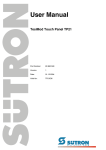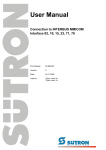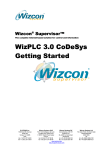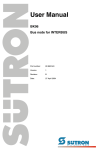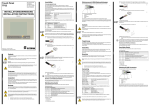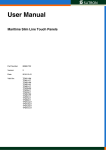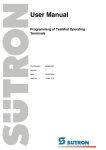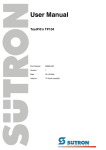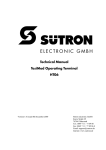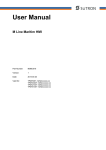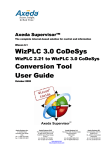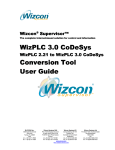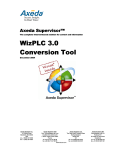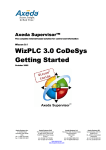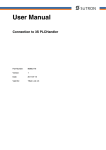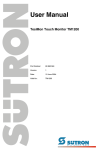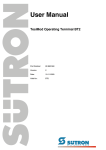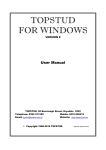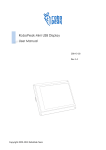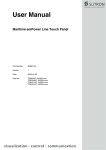Download User Manual Connection to 3S symbolic
Transcript
User Manual Connection to 3S symbolic Part Number: 80 860.632 Version: 2 Date: 25.11.2005 Valid for: TSwin .net 4.0x TSwin .net 4.1x Version 1 2 Date 04.07.2005 25.11.2005 Modifications First edition Validation extended, chapter "Important Notes" added This manual, including all illustrations contained herein, is copyright protected. Use of this manual by any third party in departure from the copyright provision is forbidden. No part of this manual may be reproduced, translated or electronically or photographically archived or altered without the express written consent from Sütron electronic GmbH. Violations shall be cause for damage liability. Sütron electronic reserves the right to make any changes that contribute to technical improvement. Overall Table of Contents Overall Table of Contents 1 2 Important Notes ....................................................................................................... 1-1 1.1 Symbols .................................................................................................... 1-1 1.2 Safety Notes ............................................................................................. 1-1 1.3 Intended Use............................................................................................. 1-1 1.4 Target Group............................................................................................. 1-2 3S symbolic ............................................................................................................. 2-1 2.1 2.1.1 Single Variables ................................................................................... 2-1 2.1.2 String Variables ................................................................................... 2-1 2.2 A Data Types................................................................................................ 2-1 Programming ............................................................................................ 2-1 2.2.1 Protocol Parameters ............................................................................ 2-1 2.2.1.1 Baud Rate...................................................................................................................2-1 2.2.1.2 Parity...........................................................................................................................2-2 2.2.1.3 Data Bits .....................................................................................................................2-2 2.2.1.4 Stop Bits .....................................................................................................................2-2 2.2.1.5 Waiting Time for Response ........................................................................................2-2 2.2.1.6 Delay until Connection Set-Up....................................................................................2-2 2.2.1.7 Byte Order ..................................................................................................................2-3 2.2.1.8 Controllers ..................................................................................................................2-3 2.2.1.9 Path for Variable List *.sym ........................................................................................2-3 2.2.2 Polling Area ......................................................................................... 2-3 2.2.3 Status Messages ................................................................................. 2-3 2.2.4 Date and Time ..................................................................................... 2-4 2.2.5 Variant Buffer ....................................................................................... 2-4 2.2.6 Tables .................................................................................................. 2-4 2.2.7 Physical Connection ............................................................................ 2-5 2.2.7.1 Pin Assignment for Operating Devices with an Universal Interface............................2-5 2.2.7.2 Cable SER1 RS232 - Schraml PLC FWM105 ............................................................2-6 2.2.7.3 Cable SER1 RS232 - Schraml SPS FWM160............................................................2-6 2.3 Error Messages......................................................................................... 2-7 2.4 Applications............................................................................................... 2-8 2.4.1 CoDeSys Version 2.2 or Higher........................................................... 2-8 2.4.1.1 Declaring Global Variables .........................................................................................2-8 2.4.1.2 Activate Output into Symbol File.................................................................................2-8 2.4.1.3 Target System Settings ............................................................................................2-10 2.4.1.4 Variable List ..............................................................................................................2-11 Index ........................................................................................................................A-1 i Overall Table of Contents ii Important Notes 1 Important Notes 1.1 Symbols The symbols in this manual are used to draw your attention on notes and dangers. Danger This symbol is used to refer to instructions wich, if ignored or not carfully followed could result in personal injury. Note This symbol indicates application tips or supplementary notes. Reference to source of information This symbol refers to detailed sources of information on the current topic. 1.2 Safety Notes – Read this manual carefully before using the operating device. Keep this manual in a place where it is always accessible to all users. – Proper transportation, handling and storage, placement and installation of this product are prerequisites for its subsequent flawless and safe operation. – This user manual contains the most important information for the safe operation of the device. – The user manual, in particular the safety notes, must be observed by all personnel working with the device. – Observe the accident prevention rules and regulations that apply to the operating site. – Installation and operation must only be carried out by qualified and trained personnel. 1.3 Intended Use – The device is designed for use in the industry. – The device is state-of-the art and has been built to the latest standard safety requirements. However, dangerous situations or damage to the machine itself or other property can arise from the use of this device. – The device fulfills the requirements of the EMC directives and harmonized European standards. Any modifications to the system can influence the EMC behavior. 1-1 Important Notes 1.4 Target Group All configuration and programming work in connection with the automation system must be performed by trained personnel only (e.g. qualified electricians, electrical engineers). The configuration and programming personnel must be familiar with the safety concepts of automation technology. 1-2 3S symbolic 2 3S symbolic The protocol provides random read and write access to all global data objects of the controller. The programming software adopts the data objects of the project_name.SYM file which are created when the CoDeSys project is compiled. The connected operating device uses the symbolic name to access a data object. 2.1 Data Types The length of a variable is determined by the length defined in the programming software CoDeSys. 2.1.1 Single Variables You can access variables of the following type: BOOL, BYTE, WORD, DWORD, SINT, INT, DINT, USINT, UINT, UDINT, REAL, and STRING. Floating point numbers are interpreted in IEEE format. The variable type REAL is required for this purpose. 2.1.2 String Variables For string variables, the variable type STRING(N) is used, where N is the length of the string. 2.2 Programming 2.2.1 Protocol Parameters With the protocol parameters, you can adapt the communication of the controller used. 2.2.1.1 Baud Rate This parameter specifies the communication rate. Table 2-1 Baud rate Configurable Values (Baud) Default Value 4800 9600 19200 38400 X 2-1 3S symbolic 2.2.1.2 Parity This parameter specifies the parity used to control the communication. Table 2-2 Parity Configurable Values Default Value None X Even Odd 2.2.1.3 Data Bits This parameter specifies the number of data bits. Table 2-3 Data bits Configurable Values Default Value 5 6 7 8 2.2.1.4 X Stop Bits This parameter specifies the number of stop bits. Table 2-4 Stop bits Configurable Values Default Value 1 X 1.5 2 2.2.1.5 Waiting Time for Response This parameter specifies how long the operating device waits for a response from the PLC. Table 2-5 Waiting time for response Configurable Values Default Value 100 ms to 25500 ms 1000 ms 2.2.1.6 Delay until Connection Set-Up This parameter specifies the waiting time after which the operating device starts the communication. Table 2-6 2-2 Delay until connection set-up Configurable Values Default Value 5 s to 255 s 5s 3S symbolic 2.2.1.7 Byte Order This parameter specifies the destination hardware's CPU type. Table 2-7 Byte order Configurable Values Default Value Intel Motorola X 2.2.1.8 Controllers This parameter specifies the runtime system of the controller. Table 2-8 Controllers Configurable Values Default Value Standard X PLCWinNT 2.2.1.9 Path for Variable List *.sym This parameter specifies the directory in which the variable list *.sym is stored. To select a directory, click the Browse button. The variable list *.sym is created by the programming software CoDeSys when compilation takes place. 2.2.2 Polling Area The poll area is used to manage the write coordination byte (WCB), the serial message channel and the LEDs in the function keys. This area is continuously polled by the operating device. This protocol requires you to set up the poll area with three single variables. Table 2-9 Data types for the poll area Area Valid Data Types KBS (write coordination byte) BYTE, USINT, WORD, UINT Message Channel WORD, UINT Function Key LEDs BYTE, USINT, WORD, UINT, DWORD, UDINT, ARRAY[1..N] 2.2.3 Status Messages Status messages are the static assignment of flags (bits) in the controller to plain text messages in the operating device. For status message addressing, use the data types BYTE, USINT, WORD, UINT, DWORD, UDINT, or ARRAY[1..N]. The following applies when using ARRAY: The type size multiplied by N provides the size of the message system in bytes. 2-3 3S symbolic 2.2.4 Date and Time The variables for synchronizing the time and date must use the data types USINT or ARRAY [1..N] OF BYTE. Table 2-10 Byte lengths for the date and time Variable Length Date with a 2-digit year 3 Bytes Date with a 4-digit year 4 Bytes Time 3 Bytes Weekday 1 Byte 2.2.5 Variant Buffer The variable for the variant buffer must use the data type BYTE or USINT. 2.2.6 Tables The variable for representation of tables must use the data type ARRAY [1..N]. The ARRAY [1..N] has to be of one of the following base data types: 2-4 – BOOL, – BYTE, – WORD, – DWORD, – SINT, – INT, – DINT, – USINT, – UINT, – UDINT, – REAL or – STRING. 3S symbolic 2.2.7 Physical Connection Plug-in connectors on the operating device for connection to the controller. 2.2.7.1 Pin Assignment for Operating Devices with an Universal Interface Table 2-11 Pin assignment RS232 Pin Designation Function 6 TD Transmitted Data 15 CTS Clear to send 17 RTS Request to send 18 RD Received data 25 SGND Signal Ground 2-5 3S symbolic 2.2.7.2 Cable SER1 RS232 - Schraml PLC FWM105 The following cabling diagram applies to operating devices with an universal interface only. Operating Device RTS CTS TD RD SGND Schraml FWM105 17 4 15 6 6 WH WH 3 18 BN BN 2 25 GY GY 5 RxD TxD GND D-SUB Male Connector 9 Pin D-SUB Male Connector 25 Pin Both ends of the shield are connected to the metallic housing. 2.2.7.3 Cable SER1 RS232 - Schraml SPS FWM160 The following cabling diagram applies to operating devices with an universal interface only. Operating Device RTS CTS TD RD SGND Schraml FWM160 17 15 6 5 18 4 25 3 D-SUB Male Connector 25 Pin TxD GND RJ45 Connector 5 Pin Both ends of the shield are connected to the metallic housing. 2-6 RxD 3S symbolic 2.3 Error Messages Error messages are displayed on the operating device along with a code and subcode. Error messages are composed as follows: Communication Error Table 2-12 Code XXXXX Subcode XXXXX Retries XXXXX Error messages for 3S symbolic Code Subcode Error Type 50 03 Framing error on serial interface 05 CRC error on serial interface 06 Parity error on serial interface 10 Poll area error 10 Wrong telegram length 20 Wrong telegram ident number 30 Wrong block number 40 Wrong checksum 50 Negative acknowledgement 60 Waiting time exceeded: no response 60 70 80 Possible Cause No poll area defined Cable interruption, connection cut-off, wrong baud rate Error from controller 50 No service Wrong service code 51 No variable list Variable list in controller is missing 20 Variable types not the same Recompile the project using the current symbol file and reload it into the operating device. 30 Invalid symbol 40 Waiting time exceeded There is no valid symbol list in the controller.Specify a higher value for Delay until Connection Set-Up 2-7 3S symbolic 2.4 Applications 2.4.1 CoDeSys Version 2.2 or Higher The programming software takes the global variables from the symbol file project_name.SYM and inserts them into the variable list. The symbolic names cannot be longer than 80 characters. The entries in the variable list cannot be modified. 2.4.1.1 Declaring Global Variables To declare global variables in CoDeSys: 1. Select Auto Declare from the Edit menu. The Declare Variable dialog opens. Figure 2-1 Example of a variable declaration for global variables 2. Select the VAR_GOBAL class from the Class field. 3. Enter a name (Message) and a type (WORD). 4. Repeat step 3 for all additional global variables. 5. Click OK to confirm your input. The Global_Variables window opens. Figure 2-2 Window Global variables 2.4.1.2 Activate Output into Symbol File Specify the following settings in CoDeSys to write the global variables into a symbolic file. 1. Select Options from the Project menu. 2. Select Symbol configuration. 2-8 3S symbolic The Options dialog will look as follows: Figure 2-3 Dialog Options - symbol configuration 3. Select the Dump symbol entries check box. 4. Click the Configure symbol file button. The Set object attributes window opens. Figure 2-4 Dialog Set object attributes 5. Select the Global variables entry. 6. Click OK to confirm your selection. You are returned to the Options dialog. Now you need to specify the position where the symbol file is to be stored. 1. Select Directories from the Options dialog. 2-9 3S symbolic The Options dialog will look as follows: Figure 2-5 Dialog Options - directories 2. From the Project area, select a directory for the compile files. 3. Click OK to confirm your selection. You are returned to the Options dialog. The symbol file will not be created until a compilation process takes place and is stored in the same directory as the project! 2.4.1.3 Target System Settings Select the following settings for the target system to ensure the symbol file is sent to the target system: 1. Open the Resources tab. 2. Double-click Target settings. The Target settings dialog opens. 3. Open the General tab. 4. Select the Download Symbol File check box. The Target settings dialog might look like the example below: Figure 2-6 2-10 Dialog Target settings 3S symbolic 2.4.1.4 Variable List The programming software automatically places the symbolic variable entries created in the example into the variable list if you specified the correct directory and name in the communications parameters. Figure 2-7 Variable list This makes the variables globally available in the programming software. 2-11 3S symbolic 2-12 Index A Index Numerics 3S symbolic....................................................... 2-1 C Cable SER1 RS232 Schraml PLC FWM105 ............................. 2-6 Schraml SPS FWM160 ............................. 2-6 I Important notes ................................................. 1-1 Intended use ..................................................... 1-1 P Protocol parameters 3S symbolic .............................................. 2-1 S Safety notes ...................................................... 1-1 Symbols ............................................................ 1-1 T Target group ..................................................... 1-2 A-1 Index A-2 Sütron electronic GmbH Kurze Straße 29 D-70794 Filderstadt Phone: 0049 711 / 77098-0 Fax: 0049 711 / 77098-60 E-mail: [email protected] Internet: www.suetron.com























